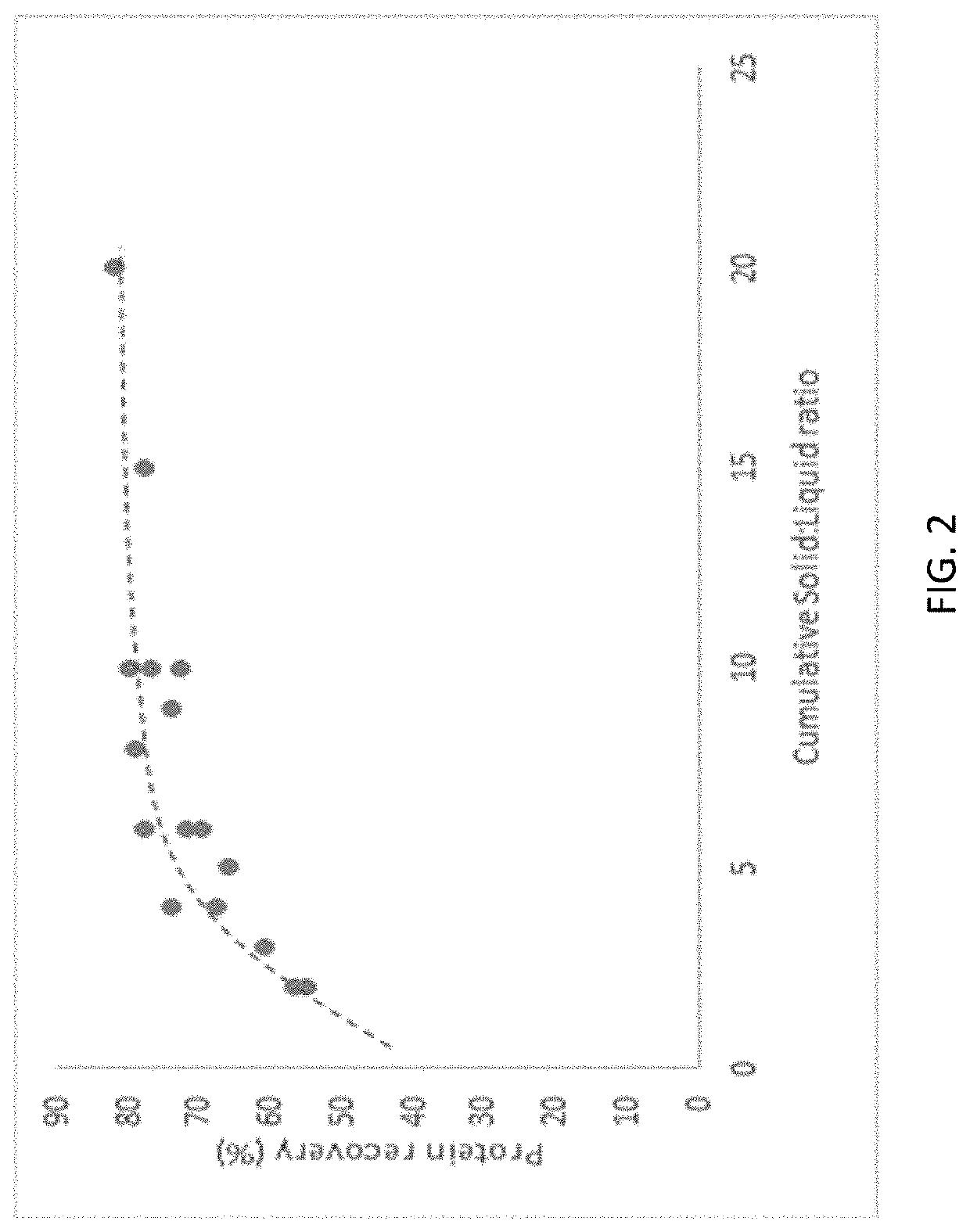Pulse Protein Isolation by Ultrafiltration
- Summary
- Abstract
- Description
- Claims
- Application Information
AI Technical Summary
Benefits of technology
Problems solved by technology
Method used
Image
Examples
example 1
ration Process for Preparing Pulse Protein Isolates
[0154]The following example discusses an exemplary process for the production of an ultrafiltered (UF) pulse protein isolate, and also the production of an isoelectrically-precipitated (IEP) control sample for use as a comparator in following examples characterizing the properties of the UF pulse protein isolate.
[0155]Ultrafiltered Pulse Protein Isolate: 40 kg of Mung bean flour (102) that was preprocessed by drying and grinding was extracted (104) with 200 kg water, 600 g salt (NaCl), 100 mL antifoam in a Breddo liquefier (Corbion Inc). The mixing was performed for 2.5 minutes. The pH at the end of the run was adjusted to 7.0 using 1 M NaOH solution. The flour slurry (105) was then centrifuged to perform a starch solid separation (106) using a decanter (SG2-100, Alfalaval Inc). The major portion of the starch solids and unextracted material (decanter heavy phase) was separated from the liquid suspension (decanter light phase). The ...
example 2
n of Extraction Parameters on Pulse Protein Recovery
[0158]The following example discusses the evaluation of various extraction parameters for effects on pulse protein recovery. The extraction of pulse proteins can be mass transfer limited or diffusion limited. Factors affecting mass transfer include mechanical factors such as temperature, solid:liquid ratio, and agitation. Factors affecting diffusion include the extraction buffer (pH, and salt concentration), and particle size. A typical extraction used in this example included 150 g ground heat treated flour (mung bean) mixed with 750 g water and 2.25 g salt (NaCl). Once homogenous, the pH of the mixture was adjusted to 7 using 1M NaOH solution. The pH adjusted flour slurry was centrifuged at 6000 G for 15 minutes in a bench top centrifuge (Lynx 6000, Thermofisher Scientific). The solid pellet was removed and the liquid was weighed, dried for total solids (by standard AOAC method—8 hours at 105° C.), protein analysis (Dumas method)...
example 3
ization of Density of Pulse Protein Isolates
[0159]The density and particle size distribution of UF and IEP isolates prepared according the methods discussed in Example 1 were analyzed. Density measurements were performed by weighing out 5 g of IEP isolate and placing the isolate in a 100 mL graduated container. The container was tapped and the volume was noted. The process was repeated with 10 g, 15 g, and 20 g of the IEP isolate, and then with 5 g, 10 g, 15 g, and 20 g of the UF isolate. Density was calculated by dividing the weight by the volume. As shown in FIG. 7A, the IEP isolate was significantly denser than the UF isolate.
[0160]The density differences illustrated in FIG. 7A are not explained by a difference in particle size of the two isolates. As shown in FIG. 7B, the particle size distribution of the IEP and UF isolates showed no significant difference in particle sizes, with nearly overlapping size distributions as measured using the mastersizer aero 3000 (Malvern Inc.). I...
PUM
| Property | Measurement | Unit |
|---|---|---|
| Temperature | aaaaa | aaaaa |
| Temperature | aaaaa | aaaaa |
| Temperature | aaaaa | aaaaa |
Abstract
Description
Claims
Application Information
 Login to view more
Login to view more - R&D Engineer
- R&D Manager
- IP Professional
- Industry Leading Data Capabilities
- Powerful AI technology
- Patent DNA Extraction
Browse by: Latest US Patents, China's latest patents, Technical Efficacy Thesaurus, Application Domain, Technology Topic.
© 2024 PatSnap. All rights reserved.Legal|Privacy policy|Modern Slavery Act Transparency Statement|Sitemap



